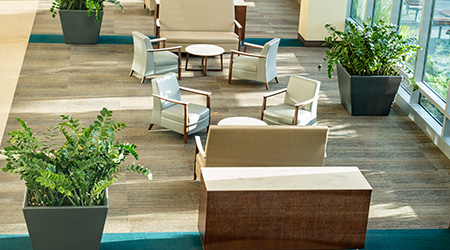Urban real estate is in high demand, but the supply is limited as the COVID-19 pandemic continues. The pandemic was a catalyst for operational and design changes in healthcare facilities, regardless of size. Designs were outdated, and many facilities were not equipped to handle COVID-19 surges. With the lack of available space for expansion, facilities are looking for ways to renovate their buildings to meet their needs, and the changes range all the way from intake to discharge.
"Like the surges we saw in 2020 and again in 2021, their effects on capacity called for better utilization of the facilities," says Walter Marin, principal with Marin Architects. "Renovations allow these facilities to make a space that both meets the needs of its patients and provides an effective workplace. With renovations, both the patient and the facility itself improve in experience. Knowing that a welcoming environment positively impacts recovery, many facilities are looking to familiarize the aesthetics of consultation rooms, waiting areas and add features like dynamic lighting and greenery to both the inside and outside of the facility."
As healthcare facilities continue to innovate, design has often had to take a backseat. Now, redesigned facilities deliver direct benefits, such as reduced infection risks, an increase in the number of rooms available, an overall increase in facility performance, lowered operational costs, and improved accident prevention.
Meanwhile, patient satisfaction is one of the driving factors in healthcare facility design. Some aspects of design need to be taken into consideration when planning a renovation, though. Planning the layout of the facility is one of the best ways to incorporate planning for the patient experience. Prioritizing the design of communal spaces allows for increased comfort and capacity.
"Oftentimes, the layouts of healthcare facilities are like labyrinths," Marin says. "With the stress of going to a healthcare facility already present, choices in scale and materiality aid patients in their navigation. Placing large main entries to direct foot traffic helps relieve the commotion of a facility’s lobby. Additionally, regardless of the needs of a patient, there tends to be a lot of waiting and visitations involved in healthcare facilities. Priorities are subject to change, depending on the kind of facility, but main aspects like intuitive layout and inviting green natural spaces are vital."
Physical environments can greatly impact an individual’s health, and design plays an important role in that process. Historically, design of healthcare facilities focused on function and not so much experience. But as the healthcare sector becomes more innovative, the focus is no longerwhere but how treatment is administered in order to be successful.
"Implementing tools like color, green space design, natural light, and vibrant design create a space that feels inviting, safe and welcoming," Marin says. "Whether or not a patient’s experience is positive will affect the decisions they make and the care they receive. While design improves the aesthetic of the space, brighter colors, green spaces, and natural light will improve the psychological quality of the facility. Ultimatelywith design, we want to create an environment that inspires a positive healthy outlook."
The COVID-19 pandemic has reinforced the importance of healthcare campuses, particularly in urban areas. Technology will remain a driving force in healthcare facilities and will create new circumstances that will change the design and layout of spaces. While there is little certainty about advances in healthcare technology, following trends allows for facility managers and other team members to determine the next stages of long-term design.
"Design should always reflect our looking to the future, but innovation will occur and call for change," says Marin. "Specifically, technology like AI in healthcare spaces will begin to direct design and value. In a fast-paced era of tech, designs, while lasting, should be adaptable as innovation brings new ideas. Following global design trends that directly affect patient and staff experience, as well as observing the changes and methods of other facilities, will ultimately help with that kind of maintenance."
Mackenna Moralez is assistant editor with Healthcare Facilities Today.

 Contaminants Under Foot: A Closer Look at Patient Room Floors
Contaminants Under Foot: A Closer Look at Patient Room Floors Power Outages Largely Driven by Extreme Weather Events
Power Outages Largely Driven by Extreme Weather Events Nemours Children's Health Opens New Moseley Foundation Institute Hospital
Nemours Children's Health Opens New Moseley Foundation Institute Hospital Code Compliance Isn't Enough for Healthcare Resilience
Code Compliance Isn't Enough for Healthcare Resilience Ribbon Cutting Marks First Phase Completion for New Montefiore Einstein Facility
Ribbon Cutting Marks First Phase Completion for New Montefiore Einstein Facility